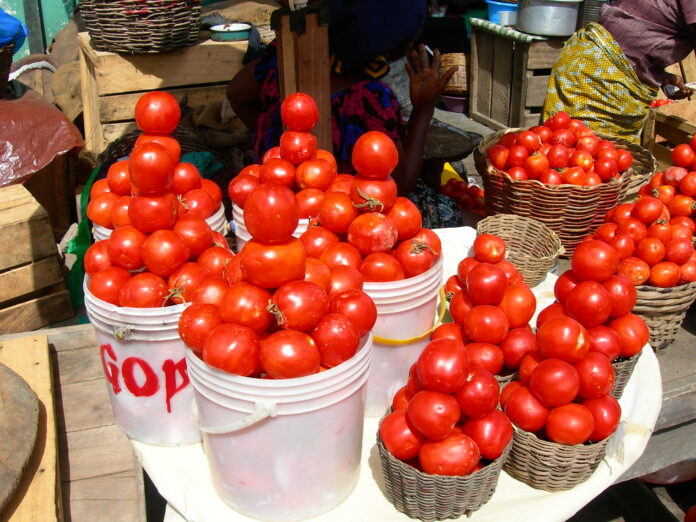Price of tomatoes in Ghana

Tomatoes are a key component in the diets of Ghanaian households. Approximately 440,000 tons of tomato are consumed annually, equivalent to 40 percent of household vegetable expenditure. Despite government support for the sector, national production has not increased much in the last decade, resulting in domestic supply falling far short of demand.
While UN Comtrade trade statistics indicate that the country imported only around 8,000 tons of tomato annually, mainly from neighboring Burkina Faso, put this figure at closer to 100,000 tons or one-quarter of domestic supply.
Also, large quantities of tomato enter the country informally, making it difficult to estimate actual supply and demand patterns and devise appropriate marketing policies. The perishability of tomato is a major challenge and imparts significant risk on producers and traders. As such, post-harvest handling, transport, storage, and processing losses have been estimated at between 20 and 65 percent of production.
What is tomato production?
Tomato, scientifically known as Lycopersicum esculentum Miller is an important and popular vegetable grown in many parts of the world. The fruit is used as an ingredient in many food preparations and is regarded as one of the most profitable crops for off-season production, preferably from May to September.
How do you maintain tomatoes?
Tomatoes require 1 to 2 inches of water per week. To encourage a healthy root system, water infrequently but deeply, rather than daily and lightly. Fertilize plants every 4 to 6 weeks throughout the growing season to keep them consistently fed and able to produce juicy tomatoes all summer.
Which month is good for tomatoes?
Tomatoes require a warm climate to grow. They are usually planted in March and April in India and harvested in the late summers.
Price of tomato in Ghana
The prices of tomatoes in Ghana are relatively high compared to the prices in the past few years. A medium-sized tomato now costs between GHS 1.50 to GHS 2.00.
A box of tomatoes is going for GHS 800 to GHS 1,000, while a small paint container of tomatoes has gone to GHS 40. The high prices are attributed to the inflation and the high dollar rate which has reduced the supply of tomatoes.
Factors that affects the price of tomatoes in Ghana
1. Weather conditions
For tomato to survive and grow healthier, it requires a specific amount of water, sunlight and heat. If the water or sunlight becomes too much, it slows down the growth and that will decrease the market supply. if market supply reduces, the prices will increase because the demand will be high.
2. Transportation
- Advertisement -
hTomatoes grown in Ghana are transported to every part of the country. That makes transportation vital in tomato production. If tomato has to be transported, fuel must be purchased and the road conditions will also be a factor. With this, prices will be high if fuel prices are high and the roads are poor.
3. Market demand
When tomato production reduces, the market price increases because demands becomes high. The demand for tomatoes can be affected by various factors such as population growth, tourism, and festivals. During peak seasons, such as Christmas and Easter, the demand for tomatoes increases, and prices typically rise as a result.
4. Production costs
Production costs include buying of seeds, fertilizers, pesticides, and labor. This makes the production easier and faster. if this production goods increases in price, then the cost of tomato will also increase in order to cover the production expenses.
5. Government policies
If the government implements a tax on tomato imports, the price of local tomatoes may increase as importers will be forced to pay higher fees. What government gives to support farmers will help stabilize the price if they are of low price making it more affordable for farmers to produce the crop.
Conclusion
The increase in tomato prices in Ghana has been a major concern for farmers, traders, and consumers alike. The lack of proper storage facilities, transportation, and market access are some of the factors contributing to this problem. While the government has taken some steps to address this issue, there is a need for more sustainable solutions to ensure that consumers have access to affordable and healthy produce and for farmers to earn a decent income for their hard work.


